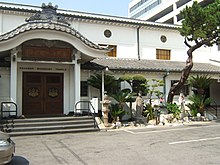Little Tokyo Historic District
Little Tokyo (also Sho-Tokyo, Lil 'Tokyo, Japantown or J-Town) is a district in Los Angeles with around 30,000 inhabitants (as of 2006). Established under the Immigration Act of 1924 , it is the cultural center of the Japanese population in southern California . The Japantown was on 22 August 1986 as a Historic District in the National Register of Historic Places entered. On June 12, 1995, the Little Tokyo Historic District was recognized as a National Historic Landmark .
Sights include the Japanese American National Museum (with an exhibition on the history and culture of Japanese immigrants), the Museum of Contemporary Art (with a collection of paintings and sculptures by famous artists), the David Henry Hwang Theater, and other traditional Japanese theaters. The Japanese American Cultural and Community Center deals with the resentment of the two peoples that arose in the 20th century .
In the district there is also a monument to the Japanese astronaut Ellison Shoji Onizuka , who died in the Challenger disaster in 1986 . The Go For Broke Monument commemorates the Americans of Japanese descent who fell in World War II .
The neighborhood is full of Japanese shops, sushi bars and Japanese gardens. The old houses from the founding time fit in well with today's cityscape. Major events during Nisei Week , an annual festival of Japanese culture and history in August, include the Grand Parade and Tofu Festival .
See also
Web links
- Little Tokyo Community Council
- Japanese American Cultural and Community Center
- Japanese American National Museum
- Little Tokyo Service Center
- Nisei Week Festival
Individual evidence
- ↑ Entry in the National Register Information System . National Park Service , accessed May 24, 2016
- ↑ Listing of National Historic Landmarks by State: California. National Park Service , accessed August 1, 2019.
Coordinates: 34 ° 3 ′ 5.5 ″ N , 118 ° 14 ′ 33.2 ″ W.


